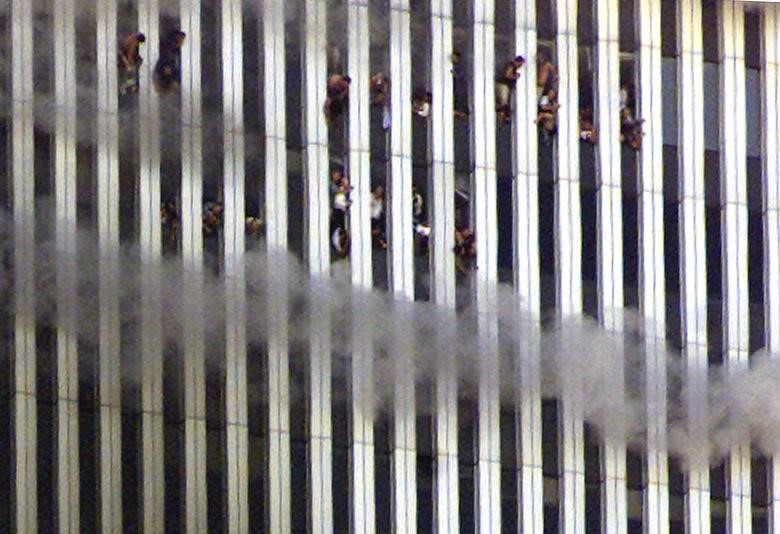Every year at the beginning of September, two beams of light rise from the southern tip of Manhattan, shooting four miles up into New York City’s sky. They mimic the shape of the World Trade Center and its Twin Towers, and for the week leading up to Sep. 11, they mark the anniversary of the deadliest terrorist attacks in history, when two hijacked planes all but pulverized the city’s tallest buildings and the certainties of the world they symbolized.
The beams are visible for miles, a powerful projection of New York’s determination not to let hate and fear change its quintessential resilience, its bedrock then and today, twenty years later.
It isn’t that the city needs reminders of the attacks and its nearly 3,000 victims: its grief is dull but ever present. Much like the loss of a loved one, which never dissipates no matter how much time passes, it is triggered every time a New Yorker gets a glimpse of the Freedom Tower, the gleaming high-rise that has since risen from the crater that was Ground Zero. The unexpected encounter with a forlorn “World Trade Center” subway sign often has the same effect, as does the persistent feeling that, no matter the amount of new construction, a hole still lingers in downtown Manhattan.

This is true for all New Yorkers, even though the average resident today wasn’t but a teenager on the day of the attacks, and many who now call the city home have never even seen the Twin Towers in person. Still, they carry the trauma of the crashing planes, the disintegrating skyscrapers, the falling men, because they live in a city profoundly reshaped by them.
As such, the twin beams projecting upwards into the sky every September offer everybody an opportunity for catharsis. They make New Yorkers stop, for a moment at least, to contemplate the impossible extent of what happened on that terse Tuesday in September, the tragic absurdity of it all. Residents new and old can let themselves feel the horror of that day, and draw strength from the courage that two decades ago held the city back from the brink of collapse.
The date of Sep. 11, 2001, carries a different meaning here than in the rest of America. The attacks are for New York an intimate wound. In this city, which would remain covered in dust and toxic fumes for weeks, first responders continue to die twenty years on of the cancers caused by their exposure to the debris. The anniversary, therefore, evokes less the hurt pride of a nation that lost its illusion of invincibility, and more the tragedy of a city that buried thousands of its own, and a part of itself.
Of course, all Americans share in the grief, and this year in particular take stock of what these past 20 years have meant.
The U.S.’s shambolic withdrawal from Afghanistan last month is a bitter place to start. The war that would ostensibly vindicate the victims of 9/11 has ended near where it started: the Taliban are again in charge, and seem to have already begun the work of undoing any progress on human rights that may have been achieved in these two decades.
Yes, Osama bin Laden is dead, and Al Qaeda is diminished, though it is not vanquished. But even these victories came at an extraordinary cost. Nearly 7,000 Americans died in Afghanistan, as did almost 2,000 NATO servicemembers and 100,000 Afghans—half of whom civilians. America’s longest war had a steep price tag, too: $2 trillion, or a staggering $300 million per day.
The attacks, and the conflicts that ensued, also reshaped domestic U.S. politics, and not for the better. They provided fodder for a narrative of hate that ultimately resulted in the election of Donald Trump, and continues to threaten the American democracy to this day. It exacerbated race- and religious-based discrimination, Islamophobia and diffidence toward minorities.
It’s yet to be seen who won the war on terror, but it likely wasn’t America.
But New York, where commemorations on this twentieth anniversary focus on mourning the victims of the attacks and celebrating the heroes that emerged that day, did prevail.
In the years after the attacks, the city turned outward, not inward. Today it has more parks than ever before, more shared spaces and infrastructure for its citizens. It is also more diverse than ever, and has some of the country’s most tolerant views on immigrants and refugees. Only days ago, people here took to the streets to ask the U.S. government to take care of Afghan allies left behind in its hasty withdrawal.
To be sure, the legacy of 9/11 is complex. New Yorkers, for example, have to live with an ever-imposing police force that uses the threat of terrorism to liberally deploy surveillance techniques on regular citizens.
Yet the attacks did not fundamentally change the spirit of the city—if anything, they proved it can survive anything. Today, twenty years later, New York is slowly and doggedly building itself back again from yet another tragedy, a pandemic that has already left 33,000 dead in its wake.
